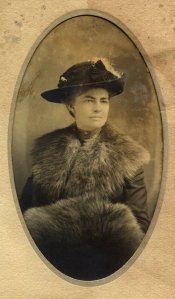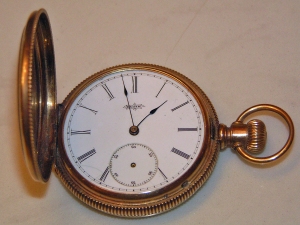Jane Dunaway was one of Missouri’s First Female Physicians —
The University of Missouri’s School of Medicine’s second woman graduate, Dr. Jane Dunaway, received her medical degree in 1905. Born in 1879, Dunaway grew up in Cedar County, Mo. as one of 14 children in a farm family. She moved to El Dorado Springs, Mo. to help her brother Louis fight an influenza outbreak. She operated a three-bed hospital in a downtown building. Dunaway’s focus shifted to psychiatry, and she joined the medical staff at State Hospital No. 2 in St. Joseph. After 30 years in psychiatry, she retired in 1960 at the age of 81. – The Missouri Women’s Council
Jane Dunaway, who I’ve written about before, was my husband’s maternal great, great aunt. According to my mother-in-law her Aunt Jane
“was quite a striking woman and usually wore a cape and a big felt hat of some kind.”
While I don’t have any photos of her wearing a cape I do have a photo of her in a fur trimmed coat with a fur hand muff wearing a hat with a feather and a pin. I’m hopeful that this qualifies for the 16th edition of Smile for the Camera, which is Bling Ancestors. While we don’t have any of the items in that photo we do have Jane’s pocket watch, which still works.
My husband acquired the pocket watch only a few years ago when his mother gave it to him to add to our clock collection. According to his mother when Jane died in 1970 the watch became the property of Jane’s niece, Rubi Garee. When Rubi died in 1987 the watch went to Rubi’s sister, Elizabeth Bullard. Then after Elizabeth’s death in 1988, her daughter (my husband’s mother) became the owner.
The front cover is engraved with an elk standing at ¾ left profile with his head turned to his left. The back cover has a side paddle wheel steamship underway on the left side with a “T” shaped building on the right side.
Prior to 1920 watchmakers made the movements in standard sizes and case makers made the cases in standard sizes as well. A person wanting a watch would purchase the movement s/he desired and then choose the case separately.
This pocket watch is by Dueber/Elgin. Elgin National Watch Co. made the watch works while Dueber Watch Case Manufacturing Co. made the case. Dueber used different trademarks to designate the grade of its cases and the trademark on this one signifies that it was a 14K gold-filled case guaranteed to last 25 years.
This case has three hinged covers on it, one over the dial, one covering the outer back plus an inner back cover. Pictures of loved ones were often placed in between the inner and outer back covers. Once the back cover is open you can then swing open the inner cover to see the back of the watch and view the internal workings. This is where the serial number 1940956 is located. From the serial number we learned that the movement was made in 1885.
The pocket watch is a hunter style meaning that the stem is located at the 3:00 position (railroad styles have the stem at the 12:00 position). It is lever set, which describes the way you set the time. You have to open the front cover, and carefully pull the lever out, which is located at about the 21 minute mark. Then you turn the pendant to set the time, when finished push the lever back in. It is a size 6s, grade 94, with 11 jewel movement. The grades are assigned to distinguish the quality of tuning and finish in the watch movement. Grade 94 seems to be a pedestrian grade, as evidenced by the 11 jewel, unadjusted movement. From a 1887 wholesale catalog we learned that this grade of pocket watch cost about $14.50.
So, we know that this pocket watch was made in 1885 when Jane was 6 years old making it seem unlikely that she was the first owner. While the size 6 is not a large pocket watch it is pretty good sized for a woman, who might have chosen the zero or 3 size. Apparently, pocket watch cases were sometimes more ornate for women than men and the design on this one seems more masculine. I wonder if the original owner was Jane’s father, older brother, grandfather or some other significant male. Most physicians today use watches with a second hand and this one, while the hand is now missing, has that function so I wonder if someone gave Jane the watch to use in her work. We may never know but learning the age of this pocket watch has answered a few questions but raised a few new ones.
Further information:
University of Missouri Savitar 1905 Yearbook
Antique Pocket Watches – Frequently Asked Questions
Wages and earnings in the United States, 1860-1890 By Clarence Dickinson Long
Answer at Yahoo to the question “What were the average earnings of people in the 1870’s to 1880’s?”





As usual, awesome research. I’m always impressed with your thoroughness.
LikeLike
I can’t take credit for all the pocket watch research, Keith did it.
LikeLike
L-U-V it! What a treasure! Thank you for sharing Aunt Jane and the watch PLUS all the fantastic research. Good job! V.
LikeLike
Thanks for reading and letting me know your feedback.
Sent from my iPhone
LikeLike
That watch is stunning!
LikeLike